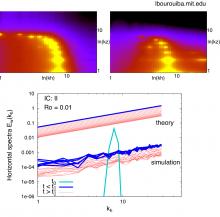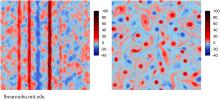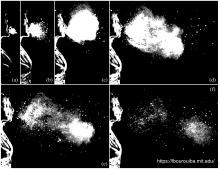Turbulence and Multiphase Flows
 |
Non-local energy transfers in rotating turbulence at intermediate Rossby number |
Turbulent flows subject to solid-body rotation are known to generate steep energy spectra and two-dimensional columnar vortices. The localness of the dominant energy transfers responsible for the accumulation of the energy in the two-dimensional columnar vortices of large horizontal scale remains undetermined. Here, we investigate the scale-locality of the energy transfers directly contributing to the growth of the two-dimensional columnar structures observed in the intermediate Rossby number (Ro) regime. Our approach is to investigate the dynamics of the waves and vortices separately: we... more |
| Nonlocal interactions and condensation in forced rotating turbulence |
The Rossby number, Ro=U/L2Ω, is the non-dimensional number characterizing rotating flows. Here U is the characteristic velocity, L the characteristic length scale, and 2Ω is the Coriolis parameter. When Ro → 0 the nonlinearity of the equations of motion becomes weak, and the theories of weak wave interactions apply. The normal modes of the flow can be decomposed... more |
|
| Quantification of the discretization effects in the representation of key inertial-wave interactions in rotating turbulence |
The Navier-Stokes equations in a rotating frame lead to solutions characterized by interactions between wave modes. In asymptotic and weak-turbulence theories, resonant and near-resonant interactions between those modes are expected to be dominant. It is imperative to sufficiently resolve the near- resonant interactions that are thought to be important in the strong rotation limit. When rotating turbulence is studied in a finite-size domain, discrete effects are introduced. We investigate the discretization effects on the capture of exact and near-resonant interactions by numerical... more |
|
| Discreteness and resolution effects in rapidly rotating turbulence |
Rotating turbulence is characterized by the nondimensional Rossby number Ro, which is a measure of the strength of the Coriolis term relative to that of the nonlinear term. For rapid rotation (Ro→0), nonlinear interactions between inertial waves are weak, and the theoretical approaches used for other weak (wave) turbulence problems can be applied. The important interactions in rotating turbulence at small Ro become those between modes satisfying the resonant and near-resonant conditions. Often, discussions comparing theoretical results and numerical simulations are questioned because of a... more |
|
 |
Model of truncated fast rotating flow at infinite Reynolds number |
The purpose of this study is to examine the strongly rotating limit of a turbulent flow theoretically and numerically. The goal is to verify the predictions of asymptotic theories. Given the limitations of experimental and dissipative numerical approaches to this problem, we use classical equilibrium statistical mechanics. We apply the statistical mechanics approach to the inviscid truncated model of strongly rotating turbulence in the small Rossby number range and derive the theoretical spectra of the decoupled model. We use numerical simulations to complement these derivations and... more |
 |
Intermediate-Rossby-number range in rotating homogeneous turbulence |
Rotating homogeneous turbulence in a finite domain is studied using numerical simulations, with a particular emphasis on the interactions between the wave and zero-frequency modes. Numerical simulations of decaying homogeneous turbulence subject to a wide range of background rotation rates are presented. The effect of rotation is examined in two finite periodic domains in order to test the effect of the size of the computational domain on the results obtained, thereby testing the accurate sampling of near-resonant interactions. We observe a non-monotonic tendency when Rossby number Ro is... more |
 |
Violent Expirations: importance of the turbulent multiphase flow |
Violent respiratory events such as coughs and sneezes play a key role in transferring respiratory diseases between infectious and susceptible individuals. We present the results of a combined experimental and theoretical investigation of the fluid dynamics of such violent expiratory events. Direct observation of sneezing and coughing events reveals that such flows are multiphase turbulent buoyant clouds with suspended droplets of various sizes. Our observations guide the development of an accompanying theoretical model of pathogen-bearing droplets interacting with a turbulent buoyant... more |
